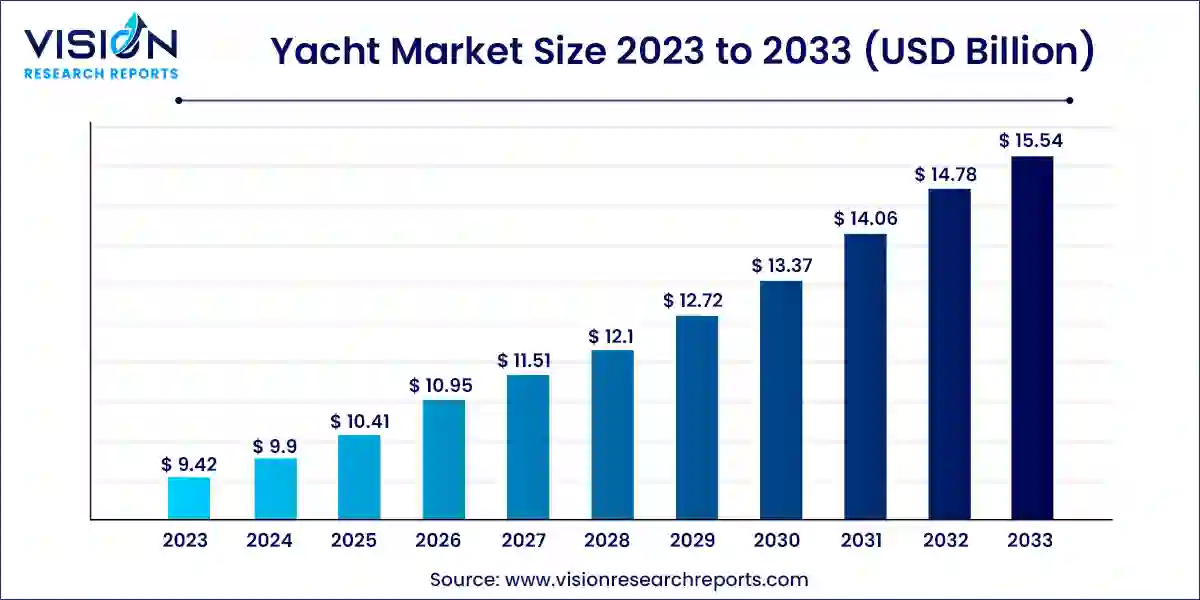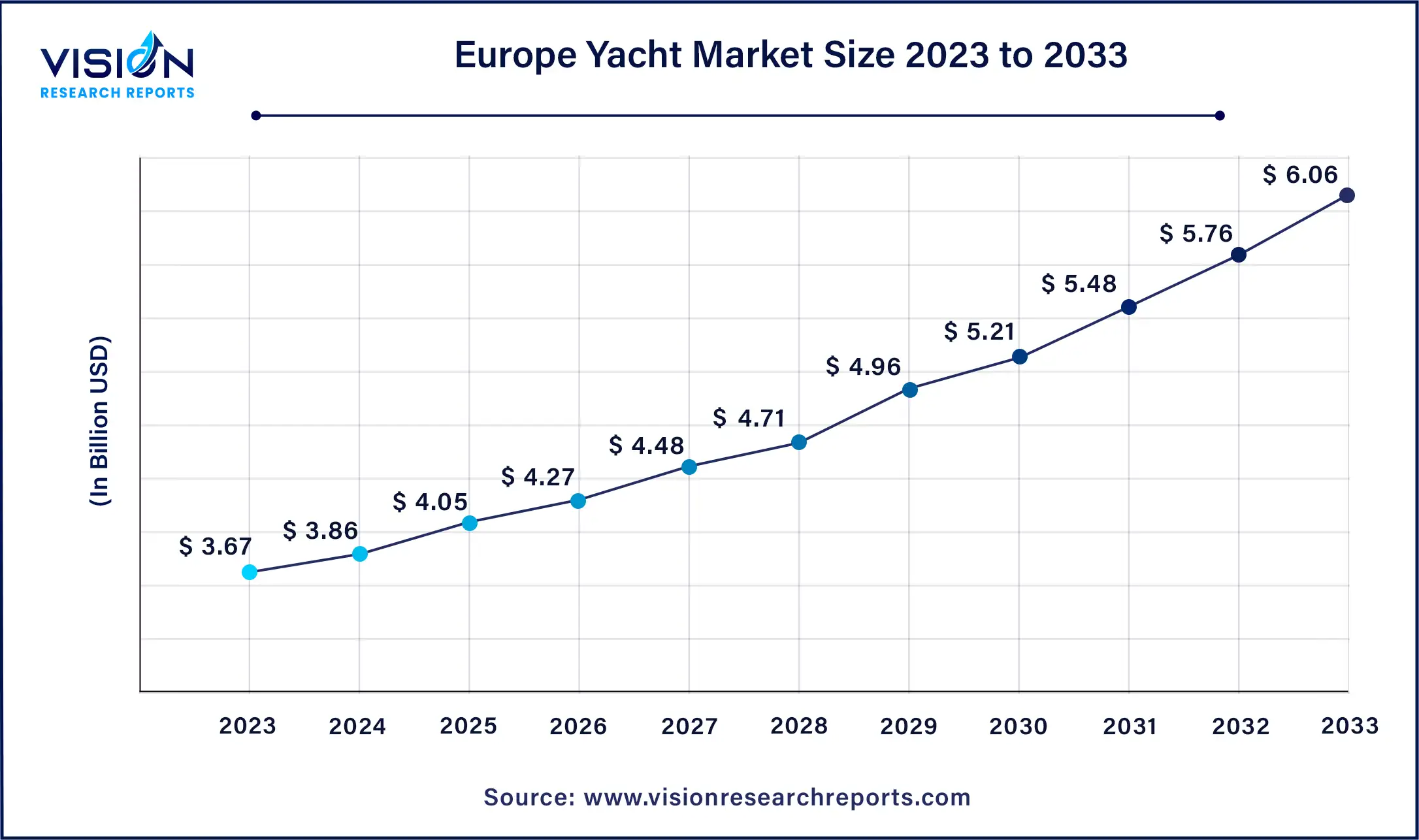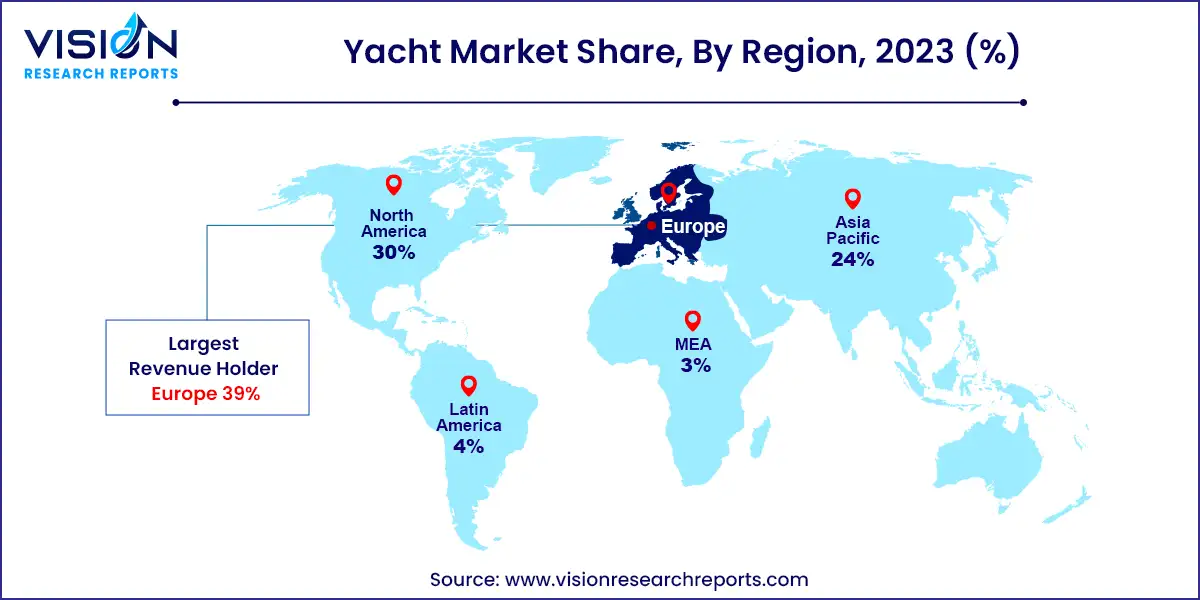The global yacht market size was estimated at around USD 9.42 billion in 2023 and it is projected to hit around USD 15.54 billion by 2033, growing at a CAGR of 5.13% from 2024 to 2033.

The yacht market is experiencing significant growth driven by the rising number of high-net-worth individuals globally is fueling demand for luxury yachts as symbols of status and leisure. Secondly, advancements in yacht technology and design, including eco-friendly innovations, are attracting environmentally conscious buyers. Additionally, the surge in maritime tourism and recreational boating activities, particularly in regions like the Mediterranean and the Caribbean, is boosting market expansion. Furthermore, the increasing availability of yacht financing options and charter services is making yacht ownership and rental more accessible. These factors combined are propelling the yacht market to new heights.
The Europe yacht market size was valued at around USD 3.67 billion in 2023 and is projected to hit around USD 6.06 billion by 2033, growing at a CAGR of 5.13% from 2024 to 2033.

The Europe yacht market dominated the global market in 2023 with the largest revenue share at 39%. This trend is propelled by the increasing presence of high-net-worth individuals (HNWIs) seeking luxurious experiences and the growing popularity of water sports and fishing activities. Europe's allure extends beyond its affluent clientele, with its stunning coastlines and growing marine tourism industry poised for continued expansion. Supportive government policies and anticipated investments in coastal regions further bolster optimism for future growth. This translates not only to a wealth of recreational opportunities beyond yachting, including white-water rafting, kayaking, and boating excursions, but also fosters a vibrant community of yacht enthusiasts. With its captivating beauty, diverse leisure options, and inclusive community spirit, Europe emerges as a quintessential yachting paradise.

The North America yacht market is projected to record a significant growth rate of 4.83% from 2024 to 2033. The market is robust and diverse, driven by a combination of affluent consumers, extensive coastlines, and a strong boating culture. The market benefits from a high concentration of ultra-high-net-worth individuals (UHNWIs), who drive demand for custom-built, high-end yachts. Innovations in technology and design, coupled with a focus on sustainability, are shaping the industry, attracting a younger demographic interested in eco-friendly yachting solutions. Canada also contributes to market growth, offering pristine cruising grounds and increasing yacht ownership. However, the market faces challenges such as regulatory complexities and environmental concerns that require ongoing attention. Economic fluctuations can impact consumer spending on luxury items like yachts.
The super yacht segment led the market and accounted for the largest revenue share of over 32% in 2023. This dominance is driven by their immense popularity among high-net-worth individuals and corporations. Superyachts, which range from 80 to over 600 feet, represent the pinnacle of luxury and extravagance in the boating world. These vessels are meticulously crafted to deliver unparalleled luxury, style, and amenities. Featuring extensive deck space, luxurious cabins, and state-of-the-art entertainment systems, these yachts offer a variety of amenities, including swimming pools, Jacuzzis, helipads, and private cinemas, all customizable to meet the owner's specific needs. Additionally, these yachts have powerful engines that ensure both comfort and style.
The sport yacht segment is expected to register the highest CAGR of 6.03% from 2024 to 2033 due to increasing demand in key markets like China and France, where participation in recreational boating and sporting events is rising among adults. Sport yachts cater to a diverse range of leisure activities, including marine tourism, sports tournaments, cruising, fishing, and various water sports. These vessels seamlessly blend the elegance and comfort of classic yachts with the performance and style of sports boats. Sport yachts are distinguished by their aerodynamic design, featuring sleek lines that embody both modern aesthetics and high performance. Their hulls prioritize minimal drag and enhanced stability, optimizing handling and the overall yachting experience. These vessels often boast well-appointed bedrooms, salons, and galleys, all designed with high-quality materials and finishes that offer both enhanced performance and luxury.
The 20 to 50 m segment dominated the market with the largest revenue share of 57% in 2023. It is anticipated to register the fastest growth rate of 5.5% from 2024 to 2033. This growth is attributed to several factors, including lower maintenance costs, fuel savings through light-wind sailing capabilities, and reduced moorage fees due to their size. Additionally, the shallow draft of these yachts allows for anchoring in diverse water depths, further enhancing their appeal.
The up to 20 m segment is expected to witness significant growth during the forecast period. The versatility of these yachts, suitable for both competitive and recreational use, is a key driver. Furthermore, North America and Europe are leading the way in using renewable energy sources like solar and wind power in marine vessels. This shift towards sustainability is expected to play a crucial role in reducing fuel consumption and emissions, particularly for these smaller, more energy-efficient yachts. The compact size and lightweight nature of these vessels make them ideal for harnessing renewable energy, further propelling growth within this segment.
The motor yacht segment dominated the market with a revenue share of 82% in 2023. It is anticipated to register a CAGR of 5.33% from 2024 to 2033. The superior speed and power of motor yachts make them ideal for efficiently traversing vast distances, appealing to those seeking a swift and versatile maritime experience. Additionally, the integration of innovative technology, from advanced navigation systems to luxurious amenities, enhances the ownership or chartering experience. Continuous innovation in equipment and technology fosters sustained growth in the motor yacht segment. As technology evolves, so do the capabilities and allure of motor yachts, ensuring they remain in high demand among consumers.
The sailing yacht segment is expected to grow at a significant pace during the forecast period. Unlike motor yachts, which rely on engines for propulsion, sailing yachts utilize sails driven by wind power, providing a unique and environmentally friendly cruising experience. While motor yachts have historically dominated with their luxurious design, spacious decks, and amenities, sailing yachts offer distinct advantages. These include serene sailing experiences, lower operating costs, and a reduced environmental footprint. The rise of sustainability-conscious consumers seeking greener alternatives in recreational boating is driving interest in sailing yachts. Additionally, advancements in sail technology, such as efficient rigging and improved hull designs, are enhancing both performance and appeal, solidifying the position of sailing yachts in the global market.
By Type
By Length
By Propulsion
By Region
Chapter 1. Introduction
1.1. Research Objective
1.2. Scope of the Study
1.3. Definition
Chapter 2. Research Methodology
2.1. Research Approach
2.2. Data Sources
2.3. Assumptions & Limitations
Chapter 3. Executive Summary
3.1. Market Snapshot
Chapter 4. Market Variables and Scope
4.1. Introduction
4.2. Market Classification and Scope
4.3. Industry Value Chain Analysis
4.3.1. Raw Material Procurement Analysis
4.3.2. Sales and Distribution Type Analysis
4.3.3. Downstream Buyer Analysis
Chapter 5. COVID 19 Impact on Yacht Market
5.1. COVID-19 Landscape: Yacht Industry Impact
5.2. COVID 19 - Impact Assessment for the Industry
5.3. COVID 19 Impact: Global Major Government Policy
5.4. Market Trends and Opportunities in the COVID-19 Landscape
Chapter 6. Market Dynamics Analysis and Trends
6.1. Market Dynamics
6.1.1. Market Drivers
6.1.2. Market Restraints
6.1.3. Market Opportunities
6.2. Porter’s Five Forces Analysis
6.2.1. Bargaining power of suppliers
6.2.2. Bargaining power of buyers
6.2.3. Threat of substitute
6.2.4. Threat of new entrants
6.2.5. Degree of competition
Chapter 7. Competitive Landscape
7.1.1. Company Market Share/Positioning Analysis
7.1.2. Key Strategies Adopted by Players
7.1.3. Vendor Landscape
7.1.3.1. List of Suppliers
7.1.3.2. List of Buyers
Chapter 8. Global Yacht Market, By Type
8.1. Yacht Market, by Type, 2024-2033
8.1.1 Super Yacht
8.1.1.1. Market Revenue and Forecast (2021-2033)
8.1.2. Sport Yacht
8.1.2.1. Market Revenue and Forecast (2021-2033)
8.1.3. Flybridge Yacht
8.1.3.1. Market Revenue and Forecast (2021-2033)
8.1.4. Long Range Yacht
8.1.4.1. Market Revenue and Forecast (2021-2033)
8.1.5. Others
8.1.5.1. Market Revenue and Forecast (2021-2033)
Chapter 9. Global Yacht Market, By Length
9.1. Yacht Market, by Length, 2024-2033
9.1.1. 20 to 50 m
9.1.1.1. Market Revenue and Forecast (2021-2033)
9.1.2. Above 50 m
9.1.2.1. Market Revenue and Forecast (2021-2033)
9.1.3. Upto 20 m
9.1.3.1. Market Revenue and Forecast (2021-2033)
Chapter 10. Global Yacht Market, By Propulsion
10.1. Yacht Market, by Propulsion, 2024-2033
10.1.1. Motor Yacht
10.1.1.1. Market Revenue and Forecast (2021-2033)
10.1.2. Sailing Yacht
10.1.2.1. Market Revenue and Forecast (2021-2033)
Chapter 11. Global Yacht Market, Regional Estimates and Trend Forecast
11.1. North America
11.1.1. Market Revenue and Forecast, by Type (2021-2033)
11.1.2. Market Revenue and Forecast, by Length (2021-2033)
11.1.3. Market Revenue and Forecast, by Propulsion (2021-2033)
11.1.4. U.S.
11.1.4.1. Market Revenue and Forecast, by Type (2021-2033)
11.1.4.2. Market Revenue and Forecast, by Length (2021-2033)
11.1.4.3. Market Revenue and Forecast, by Propulsion (2021-2033)
11.1.5. Rest of North America
11.1.5.1. Market Revenue and Forecast, by Type (2021-2033)
11.1.5.2. Market Revenue and Forecast, by Length (2021-2033)
11.1.5.3. Market Revenue and Forecast, by Propulsion (2021-2033)
11.2. Europe
11.2.1. Market Revenue and Forecast, by Type (2021-2033)
11.2.2. Market Revenue and Forecast, by Length (2021-2033)
11.2.3. Market Revenue and Forecast, by Propulsion (2021-2033)
11.2.4. UK
11.2.4.1. Market Revenue and Forecast, by Type (2021-2033)
11.2.4.2. Market Revenue and Forecast, by Length (2021-2033)
11.2.4.3. Market Revenue and Forecast, by Propulsion (2021-2033)
11.2.5. Germany
11.2.5.1. Market Revenue and Forecast, by Type (2021-2033)
11.2.5.2. Market Revenue and Forecast, by Length (2021-2033)
11.2.5.3. Market Revenue and Forecast, by Propulsion (2021-2033)
11.2.6. France
11.2.6.1. Market Revenue and Forecast, by Type (2021-2033)
11.2.6.2. Market Revenue and Forecast, by Length (2021-2033)
11.2.6.3. Market Revenue and Forecast, by Propulsion (2021-2033)
11.2.7. Rest of Europe
11.2.7.1. Market Revenue and Forecast, by Type (2021-2033)
11.2.7.2. Market Revenue and Forecast, by Length (2021-2033)
11.2.7.3. Market Revenue and Forecast, by Propulsion (2021-2033)
11.3. APAC
11.3.1. Market Revenue and Forecast, by Type (2021-2033)
11.3.2. Market Revenue and Forecast, by Length (2021-2033)
11.3.3. Market Revenue and Forecast, by Propulsion (2021-2033)
11.3.4. India
11.3.4.1. Market Revenue and Forecast, by Type (2021-2033)
11.3.4.2. Market Revenue and Forecast, by Length (2021-2033)
11.3.4.3. Market Revenue and Forecast, by Propulsion (2021-2033)
11.3.5. China
11.3.5.1. Market Revenue and Forecast, by Type (2021-2033)
11.3.5.2. Market Revenue and Forecast, by Length (2021-2033)
11.3.5.3. Market Revenue and Forecast, by Propulsion (2021-2033)
11.3.6. Japan
11.3.6.1. Market Revenue and Forecast, by Type (2021-2033)
11.3.6.2. Market Revenue and Forecast, by Length (2021-2033)
11.3.6.3. Market Revenue and Forecast, by Propulsion (2021-2033)
11.3.7. Rest of APAC
11.3.7.1. Market Revenue and Forecast, by Type (2021-2033)
11.3.7.2. Market Revenue and Forecast, by Length (2021-2033)
11.3.7.3. Market Revenue and Forecast, by Propulsion (2021-2033)
11.4. MEA
11.4.1. Market Revenue and Forecast, by Type (2021-2033)
11.4.2. Market Revenue and Forecast, by Length (2021-2033)
11.4.3. Market Revenue and Forecast, by Propulsion (2021-2033)
11.4.4. GCC
11.4.4.1. Market Revenue and Forecast, by Type (2021-2033)
11.4.4.2. Market Revenue and Forecast, by Length (2021-2033)
11.4.4.3. Market Revenue and Forecast, by Propulsion (2021-2033)
11.4.5. North Africa
11.4.5.1. Market Revenue and Forecast, by Type (2021-2033)
11.4.5.2. Market Revenue and Forecast, by Length (2021-2033)
11.4.5.3. Market Revenue and Forecast, by Propulsion (2021-2033)
11.4.6. South Africa
11.4.6.1. Market Revenue and Forecast, by Type (2021-2033)
11.4.6.2. Market Revenue and Forecast, by Length (2021-2033)
11.4.6.3. Market Revenue and Forecast, by Propulsion (2021-2033)
11.4.7. Rest of MEA
11.4.7.1. Market Revenue and Forecast, by Type (2021-2033)
11.4.7.2. Market Revenue and Forecast, by Length (2021-2033)
11.4.7.3. Market Revenue and Forecast, by Propulsion (2021-2033)
11.5. Latin America
11.5.1. Market Revenue and Forecast, by Type (2021-2033)
11.5.2. Market Revenue and Forecast, by Length (2021-2033)
11.5.3. Market Revenue and Forecast, by Propulsion (2021-2033)
11.5.4. Brazil
11.5.4.1. Market Revenue and Forecast, by Type (2021-2033)
11.5.4.2. Market Revenue and Forecast, by Length (2021-2033)
11.5.4.3. Market Revenue and Forecast, by Propulsion (2021-2033)
11.5.5. Rest of LATAM
11.5.5.1. Market Revenue and Forecast, by Type (2021-2033)
11.5.5.2. Market Revenue and Forecast, by Length (2021-2033)
11.5.5.3. Market Revenue and Forecast, by Propulsion (2021-2033)
Chapter 12. Company Profiles
12.1. Alexander Marine International (AMI) Co., Ltd.
12.1.1. Company Overview
12.1.2. Product Offerings
12.1.3. Financial Performance
12.1.4. Recent Initiatives
12.2. Azimut Benetti Group.
12.2.1. Company Overview
12.2.2. Product Offerings
12.2.3. Financial Performance
12.2.4. Recent Initiatives
12.3. Damen Shipyards Group.
12.3.1. Company Overview
12.3.2. Product Offerings
12.3.3. Financial Performance
12.3.4. Recent Initiatives
12.4. Feadship.
12.4.1. Company Overview
12.4.2. Product Offerings
12.4.3. Financial Performance
12.4.4. Recent Initiatives
12.5. Ferretti SpA.
12.5.1. Company Overview
12.5.2. Product Offerings
12.5.3. Financial Performance
12.5.4. Recent Initiatives
12.6. Flensburger Schiffbau Gesellschaft GmbH (FSG)
12.6.1. Company Overview
12.6.2. Product Offerings
12.6.3. Financial Performance
12.6.4. Recent Initiatives
12.7. Heesen Group.
12.7.1. Company Overview
12.7.2. Product Offerings
12.7.3. Financial Performance
12.7.4. Recent Initiatives
12.8. Princess Yachts Limited
12.8.1. Company Overview
12.8.2. Product Offerings
12.8.3. Financial Performance
12.8.4. Recent Initiatives
12.9. Sanlorenzo SpA.
12.9.1. Company Overview
12.9.2. Product Offerings
12.9.3. Financial Performance
12.9.4. Recent Initiatives
12.10. Sunseeker International
12.10.1. Company Overview
12.10.2. Product Offerings
12.10.3. Financial Performance
12.10.4. Recent Initiatives
Chapter 13. Research Methodology
13.1. Primary Research
13.2. Secondary Research
13.3. Assumptions
Chapter 14. Appendix
14.1. About Us
14.2. Glossary of Terms
 Cross-segment Market Size and Analysis for
Mentioned Segments
Cross-segment Market Size and Analysis for
Mentioned Segments
 Additional Company Profiles (Upto 5 With No Cost)
Additional Company Profiles (Upto 5 With No Cost)
 Additional Countries (Apart From Mentioned Countries)
Additional Countries (Apart From Mentioned Countries)
 Country/Region-specific Report
Country/Region-specific Report
 Go To Market Strategy
Go To Market Strategy
 Region Specific Market Dynamics
Region Specific Market Dynamics Region Level Market Share
Region Level Market Share Import Export Analysis
Import Export Analysis Production Analysis
Production Analysis Others
Others